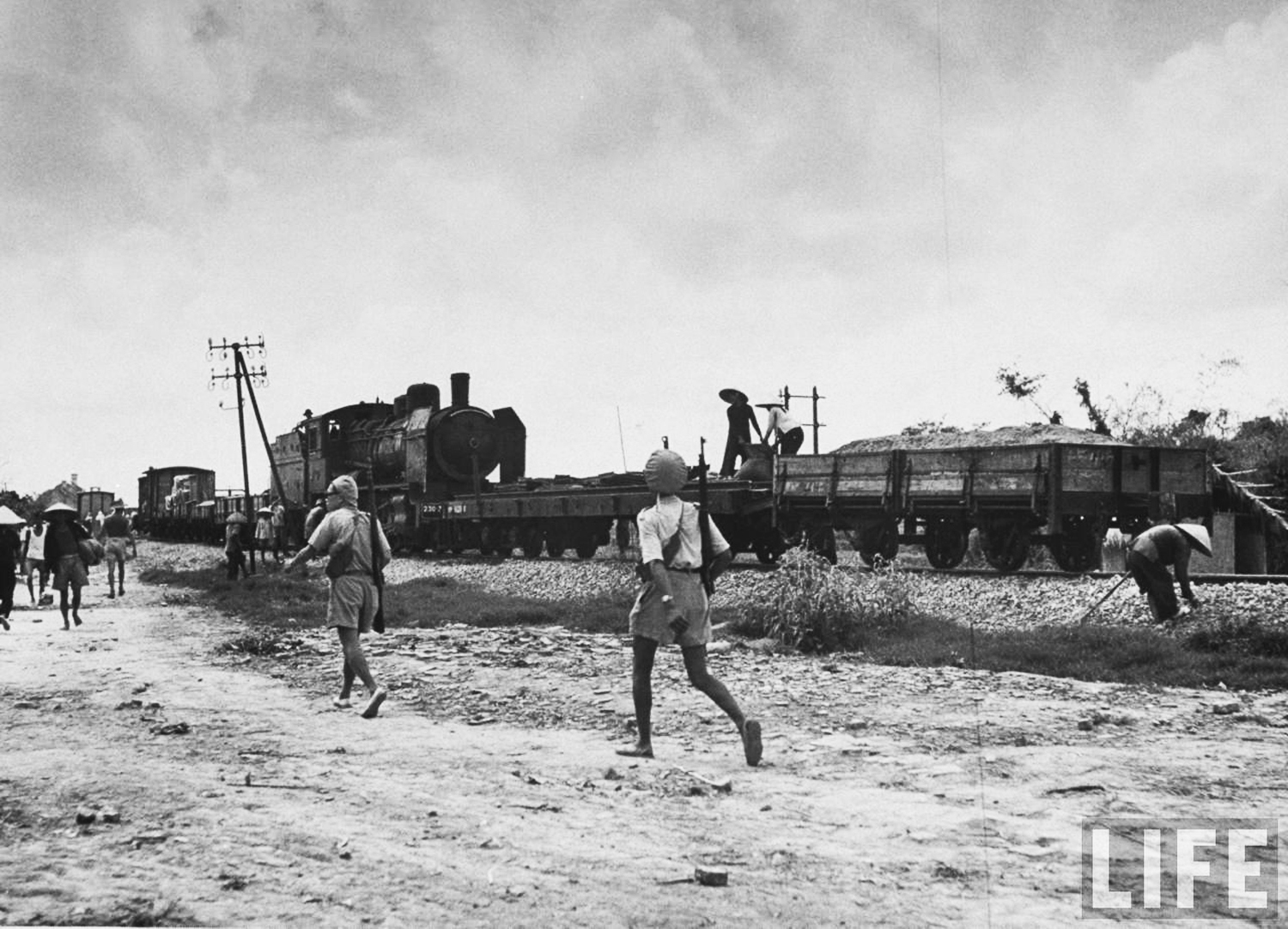
Track repairs in the early 1950s (Life magazine)
In August 1954, following the devastation of World War II and the First Indochina War, the Régie des Chemins de fer du Viet-Nam (Hỏa Xa Việt Nam) issued this leaflet outlining its ambitious development plans.
On 20 July 1954, the Geneva Accords ended the hostilities in Vietnam. Without prejudging the sequence of events, we must recognise that this date was a watershed in the history of Viet-Nam. For their part, the railways turned a painful page in their epic story.
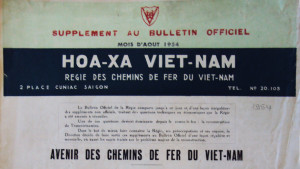
The banner heading of the HXVN leaflet issued in August 1954
Before we move forward, it would seem useful to analyse past experiences, as a way of mapping out a new path for the future.
1. History of Viet Nam Railways in the period prior to the events of 1946
The first railway line built in Viet-Nam was that from Saigon to My Tho (70kms), which was put into service on 20 July 1885. Other sections of the network were built between 1902 and 1936.
The years of opening of the various railway lines in Viet-Nam were as follows:
1901: Hanoi – Dong-Dang (162kms) – part of which, initially of 0.6m gauge, was regauged to 1m in 1901
1903: Ha Noi – Haiphong (102kms, run by the CIY), Hanoi – Vietri (73kms), Hanoi – Thanh-Hoa (175kms)
1905: Thanh-Hoa – Vinh (146kms), Saigon – Giaray (99kms)
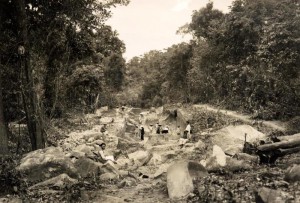
Construction of the Babonneau Tunnel, Annam, north entrance, 25 November 1933 (Fonds Vallebelle)
1906: Vietri – Laokay (224kms, run by the CIY)
1908: Tourane – Dongha (171kms)
1912: Giaray – Nhatrang (316kms)
1921: Dong-Dang – Nacham (17kms)
1927: Vinh – Dongha (320kms)
1933: Saigon – Locninh (118kms), Tourcham – Dalat (85kms, including 16kms of cog rails), Tanap – Xomcuc – Banaphao (58kms, including 40kms of cable car from Xomcuc to Banaphao)
1936: Tourane – Nhatrang (533kms, marking the completion of the Transvietnamien from Saigon to Hanoi)
Thus from 1936, the Viet-Nam Railways network amounted to 2,569kms of track, equipped with an excellent 1m gauge whose infrastructure was planned for axle loads of 13 tonnes.
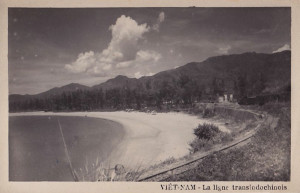
A south-central coastal stretch of the Transindochinois
The network was made up as follows: (i) 384kms (Hanoi-Haiphong-Laokay line) conceded to the CIY; and (ii) 2,185kms operated directly by the government, and comprising the so-called Réseaux non concédés (RNC).
In addition to local trains which served the different sections of line, a direct daily service in each direction ran between Hanoi and Saigon (1,729kms) in 40 hours.
The completion of the Transvietnamien [Transindochinois] in 1936, in addition to sealing the unity of Viet-Nam, also endowed it with an excellent means of communication which had already demonstrated its economic and demographic importance.
To illustrate this, one needs only to cite the annual traffic figures for the last “normal” year of that period, ie 1939.
In that year, the state network (RNC) served:
– 675 million passengers per kilometre; and
– 195 000 000 tonnes per kilometre of goods.
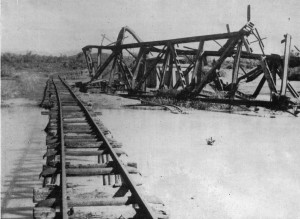
Bến Gỗ bridge near Quy Nhơn, destroyed by Allied bombing in 1943
2. The current situation of the Viet Nam Railway network
Between 1943 and 1945, during the Japanese occupation, Viet-Nam Railways suffered systematic Allied bombardment. Many bridges, large workshops (including Vinh) and an important quantity of traction and rolling stock were destroyed.
Then came the internal political and military events of 1945-1946, which completed the destruction. Between 1947 and July 1954, only the following line sections of railway line could be maintained in operation:
Conceded Railways (CIY)
Hanoi-Haiphong – 102kms
State Railways (RNC)
Hanoi-Vandien – 9kms
Tourane-Dongha – 171kms
Saigon-Ninhhoa – 463kms
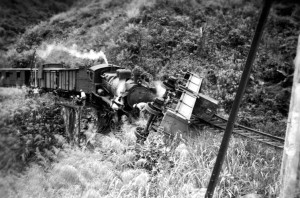
Railway bridge sabotage by Việt Minh forces
Tourcham-Dalat – 84kms
Saigon-Locninh – 118kms
Saigon-Mytho – 70kms
TOTALS – 917kms
Despite the constant attacks and sabotage to which it was subjected right up until the cease-fire, Viet-Nam Railways continued to function courageously, assuring communications between the regions it travelled through.
Even on the various lines of the state network, despite the ongoing problems, the figures remained encouraging:
Year Passenger kilometres Tonnes-kilometres of freight
1947 21,000,000 21,000,000
1948 32,000,000 39,000,000
1949 23,000,000 46,000,000
1950 24,000,000 46,000,000
1951 45,000,000 73,000,000
1952 54,000,000 91,000,000
1953 71,000,000 100,000,000
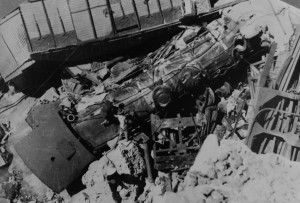
The aftermath of the Baika Viaduct disaster of of 22 June 1953 – Việt Minh forces detonated a strong explosive charge just as a fifteen-coach passenger train double-headed by two brand-new“Mikado” 141-500 locomotives arrived at the Baika viaduct (km 761). The viaduct collapsed and the entire train plunged into a ravine, killing more than 100 passengers and crew.
Alas, in order to maintain a level of traffic of this magnitude, the Régie des Chemins de fer du Viet-Nam had to pay a heavy price. From 1946 to 1953, it recorded 1,968 sabotages and 391 attacks, which wounded 753 and killed 159, among them the cream of its staff.
However, through all of these vicissitudes, the Régie des Chemins de fer du Viet-Nam never lost faith in its mission, and far from reducing its operations, it continued to extend its activities, and even diversified into areas outside the railway sector.
For example, in early 1954, in order to liaise better between the different parts of its truncated network, Viet-Nam Railways acquired three cargo ships with a total cargo-carrying capacity of 6,000 tonnes, thus becoming the first Vietnamese ship owner.
3. The need for a reconstruction programme
The cease-fire has been in force since August 1954 in the whole territory of Viet-Nam.
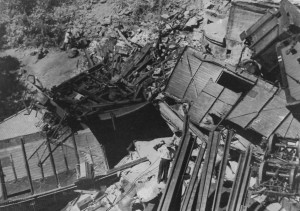
Another scene in the aftermath of the Baika Viaduct disaster of of 22 June 1953
The Régie des Chemins de fer du Viet-Nam has wasted no time repairing its lines, an immense task given that, in the almost complete absence of maintenance, this bruised network had suffered a state of abandonment for over 10 years.
It has dealt first with the most pressing issues: consolidation of damaged works, reinstatement of the worst areas of track, reconstruction of essential fixed installations, etc.
But the main activities of the Régie have been directed towards the reconstruction of the Transvietnamien. This is not so much a case of sentimental attachment to something old, but rather the reasoned will to reconstruct a fundamental economic tool for the future of Viet-Nam. The experience of the war years, and alas, the period of upset we faced in the immediate post-war years, showed that the railways, in spite of the multiple difficulties they encountered, remained a powerful and flexible means of transport, one which is always ready to serve.
Is it necessary to mention the current difficulties of evacuating and regrouping the armed forces, as set out by the Geneva Accords? When all other means of transport are overwhelmed, the railway always functions with ease, every time we call upon it, and that despite the shortage of equipment and the poor state of its track. We would have been really blessed if the original North-South line still existed in its entirety – everything and everyone would have used it!
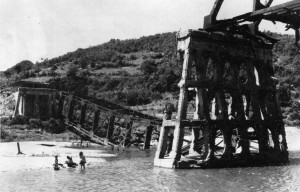
The wreckage of La Hai bridge in Phú Yên province
Must one recall also that in October 1952, in the aftermath of a typhoon of exceptional violence, such that we have not seen in Viet-Nam for centuries, the railway, in record time, re-established its normal operations, while other means of transport were still paralysed, wondering where to begin the repairs?
Finally, can we imagine that, at the very moment when a democracy has been proclaimed, one would for a single instant lose sight of the fact that the railway, despite the evolution of other transport techniques, remains an essentially democratic institution, precisely because it’s so cheap?
The reconstruction of the Transvietnamien involves the relaying of around 1,200kms of track, some 500kms of which are situated south of the 17th parallel (the section from Ninhhoa to Tourane). The reconstruction of this southern part of the Transvietnamien will absorb, at an initial estimate, credit of around 700 million dollars and will be completed in two years, thanks to the state of destruction – extended, yes, but also mainly superficial, most large works remaining recoverable.
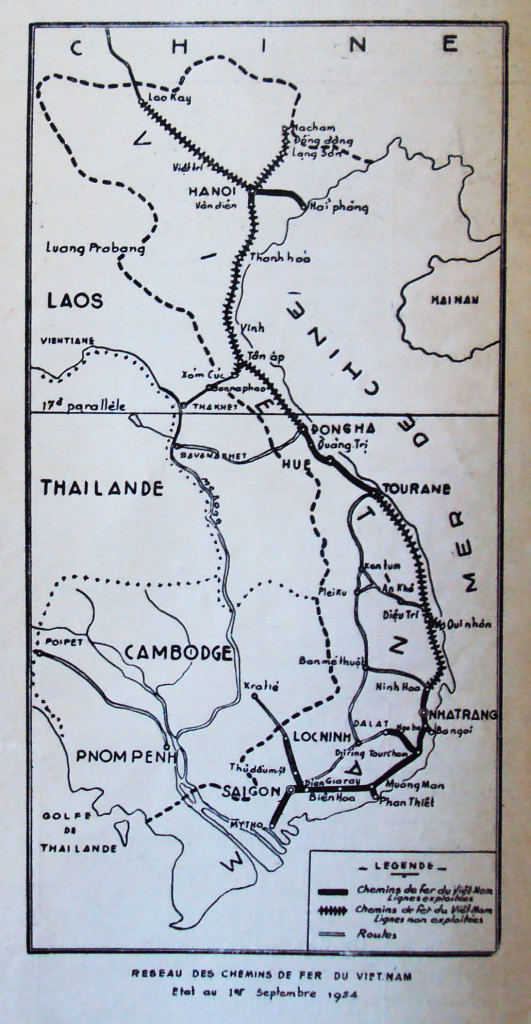
The Viet-Nam Railways network on 1 September 1954
Then in the longer term, after the reconstruction of the Transvietnamien, we might consider extending the network by building tributary lines to serve the rich inland areas whose exploitation is still very limited due to difficulties of access.
If we are limited only to new line projects south of the 17th parallel, the following should be mentioned:
– A line linking the provinces of Kontum, Pleiku and Bunmathuot to the Transvietnamien at Ninhhoa, the completion of which will benefit the economic and social development of the Highlands.
– And with the eventual rail connection to our southern neighbour, Cambodia, the extension of the Saigon-Locninh line as far as Kratie will give the products of the forests and plantations of this rich region easy access to the sea, the Mekong being difficult to navigate beyond Phnom Penh.
But before even thinking of extending the Viet-Nam Railways network, we must rebuild it and modernise its equipment, with the aim of better performance and greater circulation of trains.
Among these modernisation projects, some of which are already in the process of realisation, one should mention:
(i) “dieselisation” of motive power;
(ii) strengthening of certain works which are currently in weak condition, especially those of the former Laithieu-Bendongso tramway, to permit circulation of axle loads of 13 tonnes;
(iii) electrification of the Tourcham-Dalat and Saigon-Nha Trang routes, to be studied in connection with the hydroelectric projects at Danhim, near Dalat.
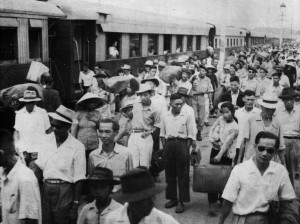
The arrival of a passenger train at Saigon Station in the 1950s
The completion of the programme briefly described here will require the mobilisation of considerable financial resources, public and private, domestic and foreign. However, after long years of war, our own immediate means are limited, and external aid remains sparse. It is therefore important not to waste such resources, but to use them wisely in the reconstruction of various means of communication, as part of a logically-coordinated plan.
In this plan, the railways will, we are sure, constitute a “key sector” whose priority reconstruction will facilitate the development of others, and whose modernisation must be a primary factor in the rebirth of Viet-Nam.
Tim Doling is the author of The Railways and Tramways of Việt Nam (White Lotus Press, Bangkok, 2012) and also gives talks on Việt Nam railway history to visiting groups.
A full index of all Tim’s blog articles since November 2013 is now available here.
Join the Facebook group Rail Thing – Railways and Tramways of Việt Nam for more information about Việt Nam’s railway and tramway history and all the latest news from Vietnam Railways.

